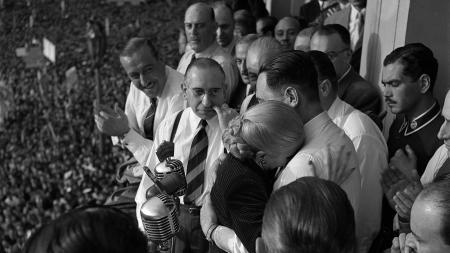The Editorial of the National University of Tres de Febrero, Eduntref, presents the “Historical Dictionary of Peronism 1943-1955”a collective work that brings together the work of 173 researchers who, with the coordination of Carolina Barry and Samuel Amaral, carried out a data book with information on historical references, facts and key institutions of that movement but also on opposition and anti-Peronist leaders.
“The objective is to provide reliable, reliable data from those of us who are dedicated to studying the first Peronism. It is not a work of opinions, it is a dictionary that provides data”explains Carolina Barry, a graduate and PhD in Political Science, in dialogue with Télam.
This work, which accounts for the history of Peronism through biographies, episodes, concepts, institutions and organizations, can be read at digital format or writing to the email [email protected].
The dictionary has 700 entries on leaders, policies, institutions, events, organizations and significant leaders during Peronism, but also period topics such as folklore, lunfardo, tango, soccer, architecture, cinema and abstract art. .
In these more than a thousand pages there is systematized information on figures such as Niní Marshall, Zully Moreno, Luis Sandrini, Tita Merello and Libertad Lamarque, the tennis player Mary Terán de Weiss, Juan Manuel Fangio, Delfo Cabrera and José Gatica, among others.
Regarding the research and systematization work, Barry says that it lasted a little over 10 years: “This work arose at the end of 2009 with the aim of providing reliable information about the main characters and events related to the first Peronism, that of the 40s and 50s. The first thing we did was make a conceptual map, that is, which entries had to be yes or yes. Once we contacted each male and female researcher, of which there were 173, we proposed them the thematic entries. This generated a dialogue between those who wrote and us as coordinators”.
“The dictionary does not end with what is related to it to this day because political history is very dynamic and there are scholars who are doing innovative work on other aspects of Peronism and which may later involve incorporating new terms or biographies of those who are not contemplated in these first 700”, says the author of “Evita Capitana: the Female Peronist Party 1949-1955” and “Evita is made: the other first Peronist ladies”.
In this sense, he adds that this book can be read out of ordersince “an entry with its hyperlinks can lead to other entries and, according to the interests of the person reading, a different map can be created”.
For Barry, the fact that 173 academics have participated shows the multiplicity of perspectives that can be found in the dictionary that expanded as it progressed: “this took more than 10 years, as we progressed, new concerns about terms and concepts appeared. That led to new terms and biographies that referred us to new ones. For example, the terms Peronism/Peronist, caudillo, gorilla.”










